
Miramichi and Cains Rivers Season Ending Update
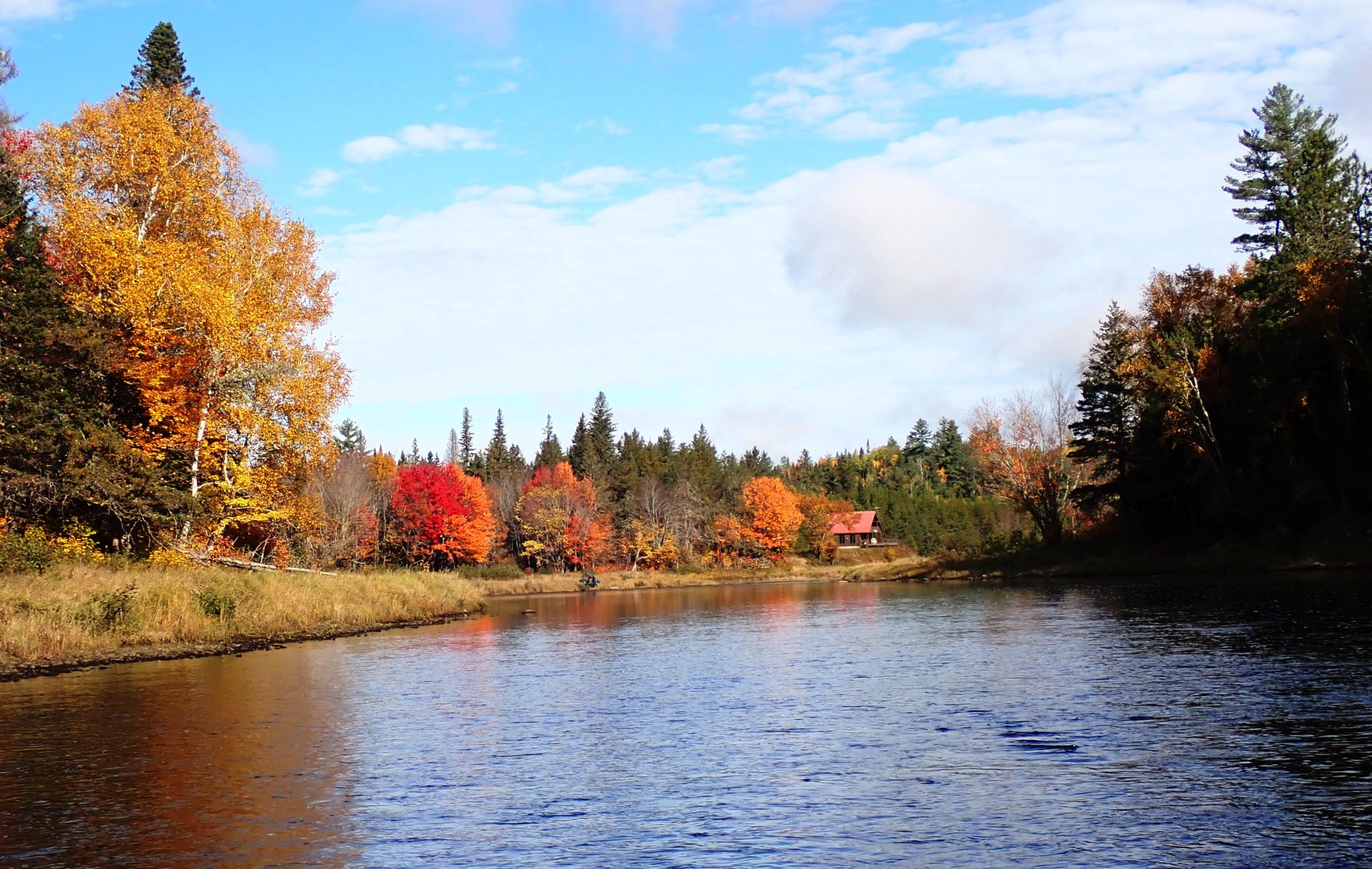
Looking downriver at the Mahoney Brook camp on the next to last day of the season. There were lots of fish in the Cains this fall, but the water was very low.
I spent the last 5 weeks of the salmon season in camp on the Miramichi fishing both the Cains and the main river. My overwhelming reflection on that time, is how great it felt to have been able to return to Canada, and go salmon fishing. Of all the fishing I’ve done anywhere, there is none that I prefer to fishing for Atlantic salmon in New Brunswick.
I’m going to cut this season wrap-up blog in half to keep it from being too long. This first part will review the fall salmon fishing. The second part will come in early November, and it will review the run for the entire season including an analysis based on the trap and barrier results.
There were a number of years in the early 2000s when the hot weather of summer dragged on into early September, and it was close to mid-September before the river really cooled down and fall fishing began. Over the last few years, though, the river seems to have substantially cooled down before the end of August, and in several summers – such as 2021 – we received quite a bit of rain. My old friend Willy Bacso used to say, that there are just so many fish to come, and if they come early on repeated raises of water, then they will be all gone upriver before the end of the season. Probably to a large degree that was the case with the fall of 2021.
Check out this graph below of water levels on the Miramichi River in Blackville. This shows the height of water in meters over the course of the 2021 salmon season.
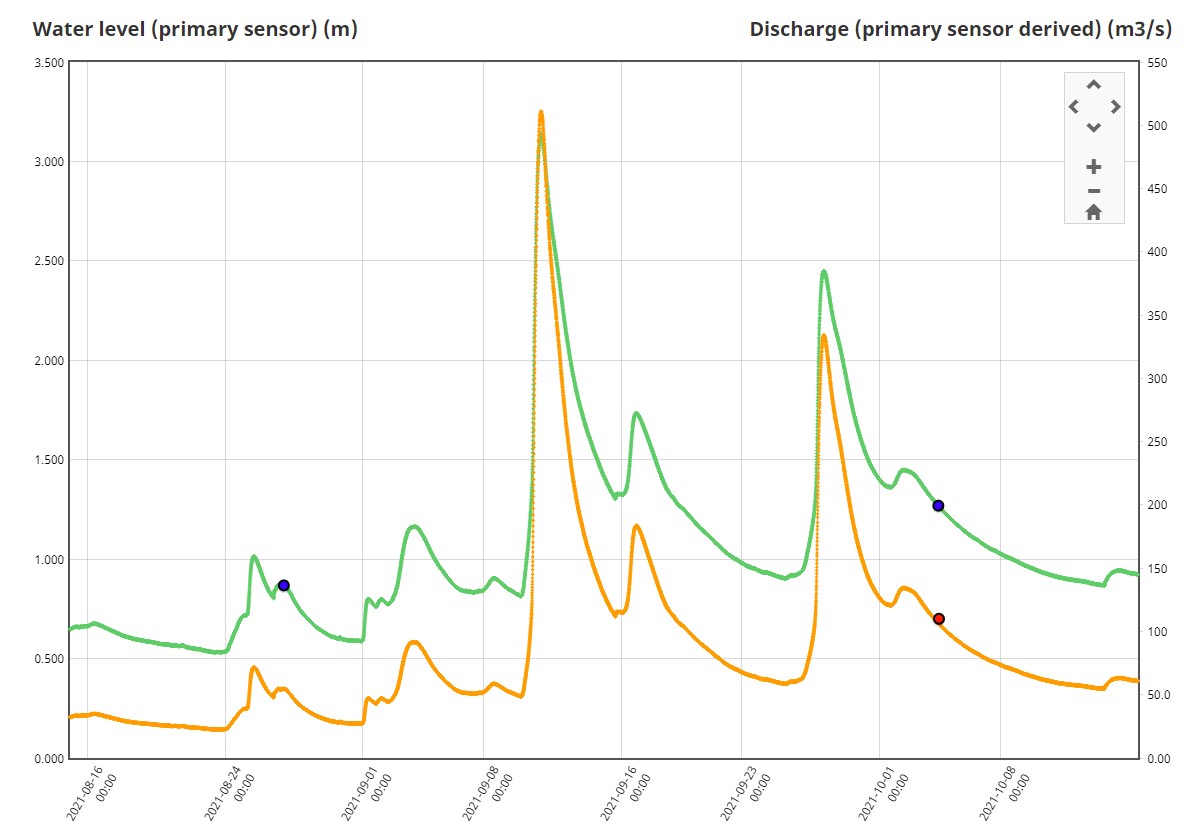
2021 Blackville, Miramichi water heights in green. Note the .5 reading in the left axis. 2020 hardly saw a day in the fall with water above that height. Anything above .8 meters or so is relatively high water.
The last time in 2021 that we saw a typical summer height of water was August 31st when the gauge registered .59 meters, and throughout all of August it was rarely anywhere near that low. In July or August that water height would find fish holding in pools along the river that offered some amount of cool water buffering. The difference in 2021 was that repeated raises of cool water had carried many of the fish further upriver than they would normally have been at that time. This left fewer fish to populate downriver pools in the fall, and the greater heights of water encouraged them to just keep on swimming instead of resting in a lie where anglers would have a crack at them.
On August 31st the maximum water temperature was a warm, but not untenable 23C or 73F. By September 3rd the height had risen to 1.2 meters – a two foot raise – and the water temperature was down to 16C or 60F – excellent. Two couples led by Graeme McKinnon who had purchased a fishing trip to Campbell’s Pool at an MSA auction the winter before showed up to fish. It was excellent timing. In 2 ½ days of fishing with guides Jason Curtis and Darrell Warren they hooked more than 30 salmon and grilse and landed 14 on the Miramichi and lower Cains River. Right place, right time!
I arrived on the 6th at mid-afternoon and had time just to fish with Jason for an hour or so, hooking two salmon and landing one of them. The next day, with the water down to just .823 meters I waded Campbell’s Pool and found fish here and there on various lies. I hooked three more that got of and landed a grilse and a 16 pound salmon. It was the best fishing I was to have all fall.
It poured rain on September 9th and by the 10th the river was rising and on its way up to 3.2 meters – a 2.5 meter raise, or approximately 8 feet! And the raises just kept on coming. The river was up again on the 17th, and another big raise came on the 27th. As each raise settled down we saw fresh fish, but less each time. The water never got below .87 meters again, and the best you could hope for was a fish to pause on a lie for a few minutes as it swam through. The combination of weak numbers of new fish and high water made for poor catching on the Miramichi. Fish also traveled well up the Cains earlier than normal. We caught our first fish of the season at Mahoney Brook, 21 miles up the Cains, at the early date of 9/17. Karl Wilson reported that they caught salmon up above Hopewell lodge – another 20 plus miles upriver – the last week in September. Many years there are no salmon seen that far up until the middle of October.
The difference on the Cains was that the raises were much smaller to non-existent. The headwaters of the Cains and the Miramichi are far enough apart so that it is possible for one to get a soaking rain, and the other hardly a drop, and it does happen. The Cains missed the large raise of September 27th almost completely. When the fish were normally moving to the upriver pools for the traditional late season Cains fishing, the height was so slow that there was little current flow in the pools, and it was very difficult to catch them. Jason Curtis said that it was the double whammy – too high for good fishing on the Miramichi and too low on the Cain!

Beautiful, but too sunny for good fishing, especially in the low water. Photo by Jesse Robbins on the Cains River.
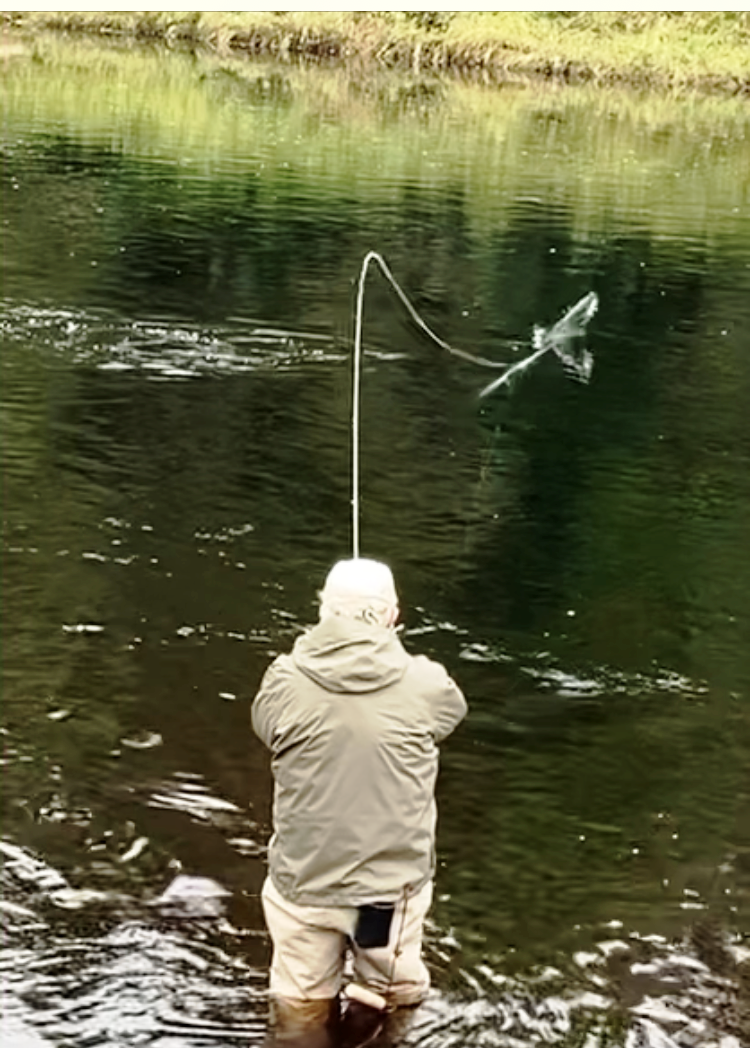
Harvey Wheeler took this remarkable photo of Duncan Barnes playing a cock salmon just as it began to jump.
That said, the fishing had its bright moments. All four members of the McKinnon group, plus Topher Browne, Pat Boland, Colles Stowell, Duncan Barnes, and myself all landed nice double-digit salmon, and others were hooked and lost. Of the 39 salmon and grilse that we landed in September and October, 14 were salmon and 25 grilse. Large male – cock or buck salmon – were conspicuously lacking. That seems likely to be a function of poor grilse returns for the last few years, since large cock salmon usually begin their careers as grilse.
Another bright spot of the fall was what I observed to be very healthy numbers of feeding parr. During early September especially, when the water was a little warmer, and the insects were hatching in the evenings, all of the many rocks throughout Campbell’s Pool hosted good numbers of feeding parr. It was very much a heart-warming sight.
The list of successful flies for us held no big surprises. I only saw water at 49F just one time while I was there. It fairly dependably stayed in the mid to high 50Fs right to the end. Because of that we hardly fished the large, streamer type flies such as the October Killer this entire fall. I did catch a few on an October Killer Jr. tied on a #4 streamer hook. Another fly that worked out well for me was a simplified play off an Allie’s Shrimp that I made my first day in camp – because I couldn’t find an Allie’s Shrimp in the size that I wanted – using red and black barred squirrel tail instead of bucktail, eliminated the golden pheasant crest, used black bear for the wing, and made the body of orange or in some cases black and orange mohair. We did catch a few in the slow water on the highly mobile marabou or slime fly patterns.
On October 2nd, well up the Cains, I had a bump from a salmon on my Allie’s Shrimp variant, but it wouldn’t come back. I have had luck before, mostly during the summer season, in these situations by going down to a much smaller fly – usually black. I tried this, going to a number 8 Undertaker with a fluorescent green butt. I caught the salmon on the first pass, and in a few minutes went back upstream to fish that lie again, and using the same fly caught a grilse. I guess the moto would be to never go out on the Miramichi or Cains without your small black flies – even in the fall.
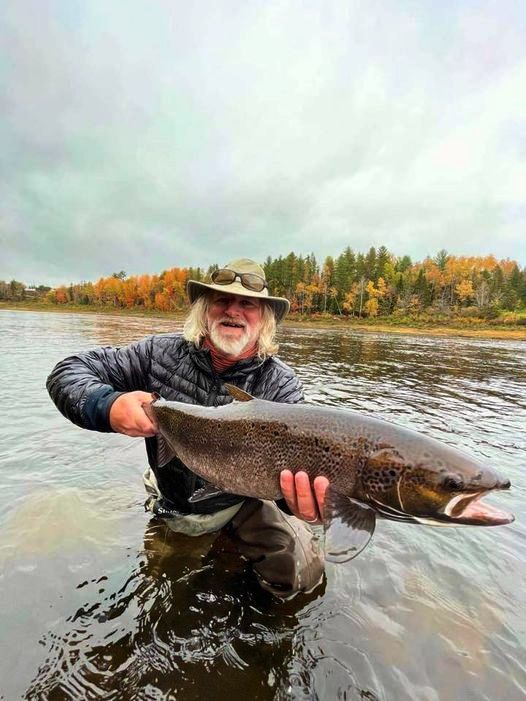
Country Haven angler Terry Roemer from NJ with a fresh late season fish from the Rapids section of the lower SW Miramichi.
As the season came to an end we were still seeing a fairly steady trickle of fresh salmon on the Miramichi. In fact Jeff Curtis fished in Blackville the morning of the last day and saw 14 different salmon roll on their way up the river. Country Haven’s anglers had some success then catching fish down in the Rapid’s section too.
The Cains experienced the tiniest increase in water height from some thunderstorms just before the end of the season, and I hoped it would freshen up the good numbers of fish holding in virtually all of the pools we normally fish, but it didn’t work out that way except for one final grilse from the home pool at Mahoney Brook.
Campbell’s, Black Brook and Country Haven teamed up to angle 6 hen salmon and 8 males for Cains River broodstock for the MSA. Those fish will be spawned out over the next week and released live back into the river. The results will be many thousands of first feeding fry to stock next May and June in areas of the Cains that were shown to have low parr counts this past summer.
I communicated with Upper Oxbow, Wilsons, Black Brook, Rocky Brook, and Country Haven after the end of the season. They were all grateful to have had the borders open and resume more or less normal operations for the fall fishing season. They thank their clients for making the trip north.
With Covid still an issue in NB for large gatherings, the MSA was forced to postpone its important Fredericton fundraising dinner to honor the Wade family. The MSA has gone forward with a large online auction featuring 100 items including virtually everything to do with salmon fishing: trips, flies, tackle, clothing, etc. Here is the link to the auction. I hope you’ll join me in doing some bidding, or in simply making a donation to this organization that is completely devoted to working for the interests of Miramichi salmon and salmon angling.
Thanks for reading. Brad Burns
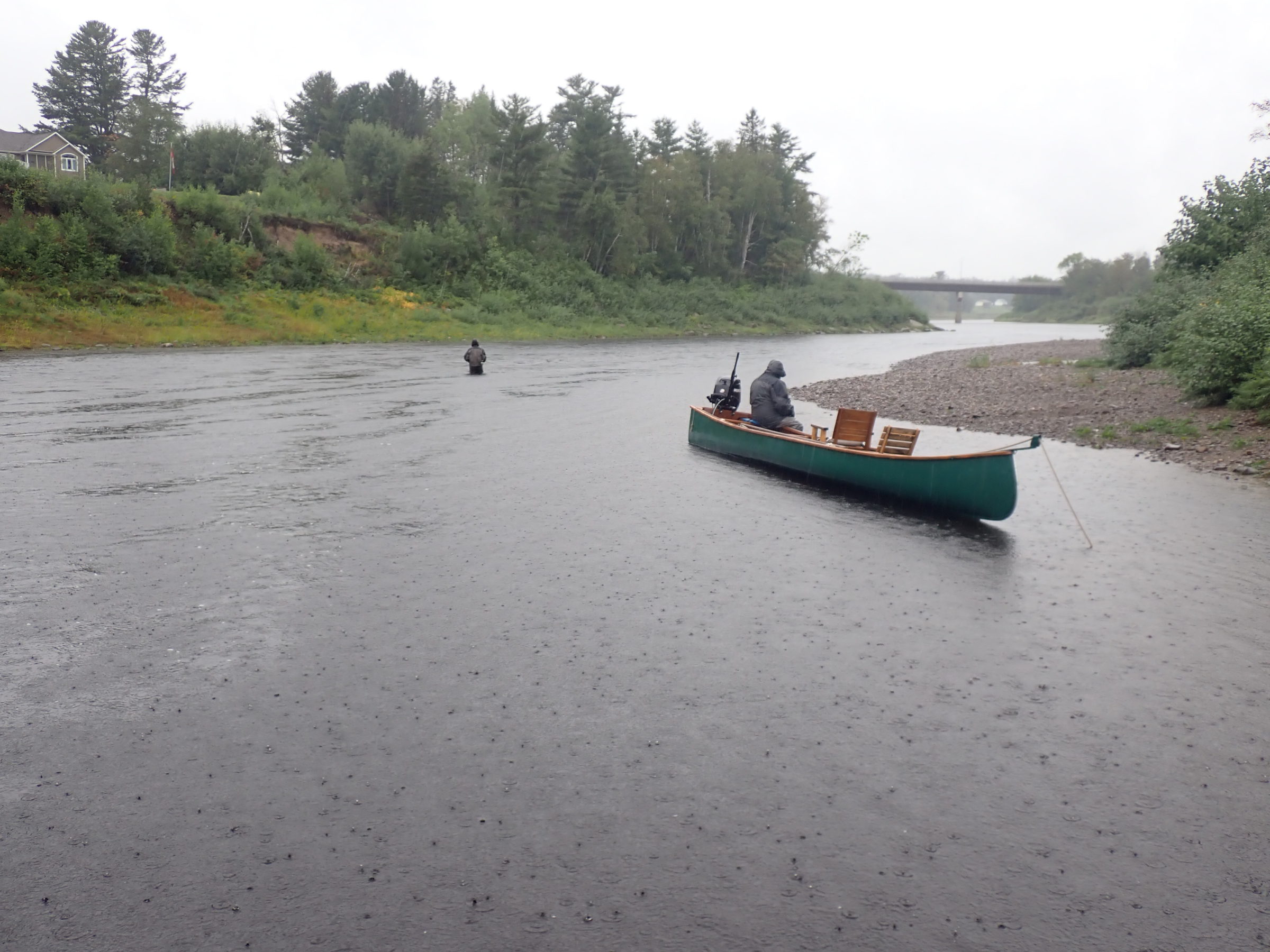
Consistent rain and resulting high water made low-water pools like Doctor’s Island practically useless this fall – but there is always next year!


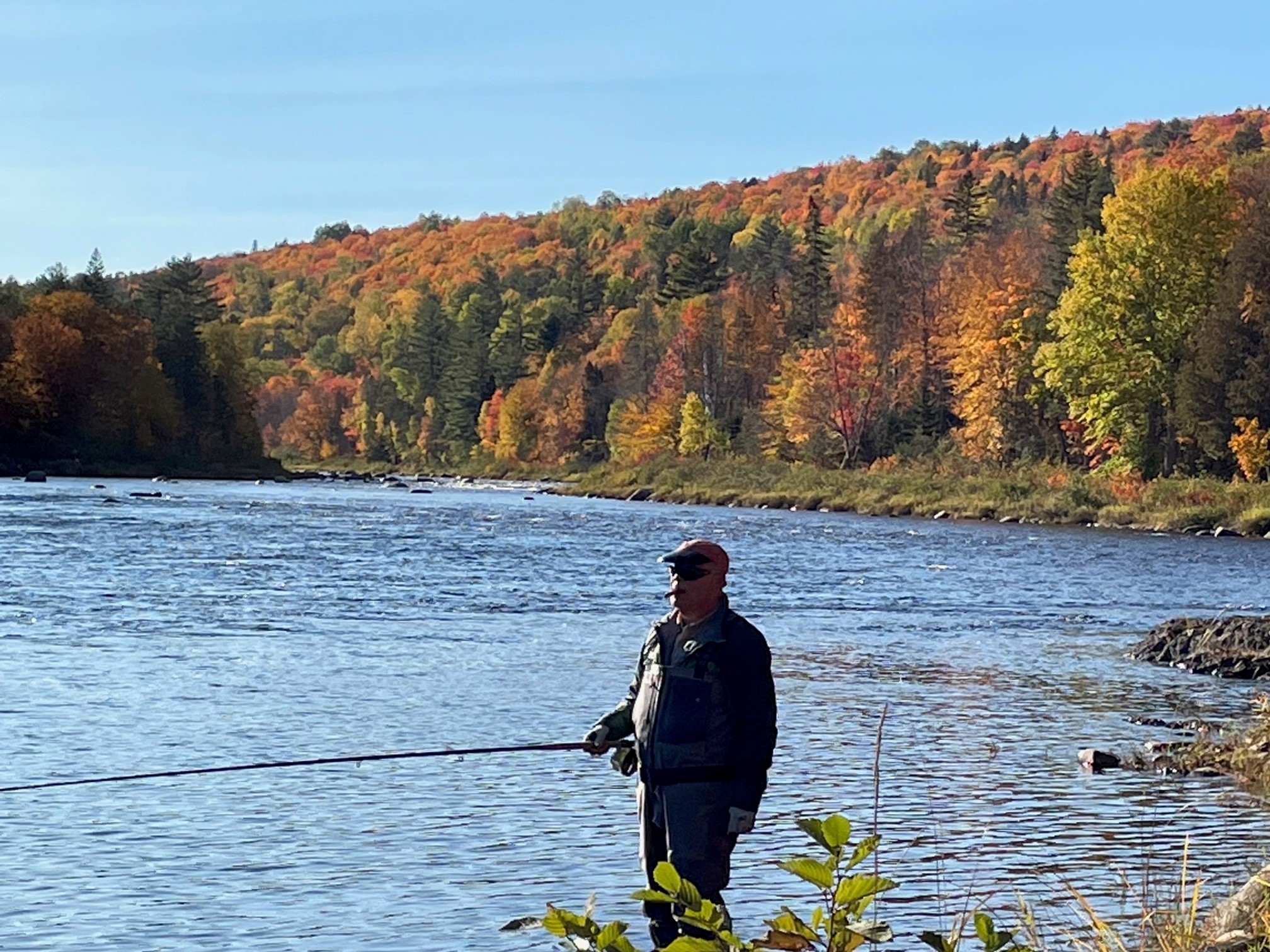
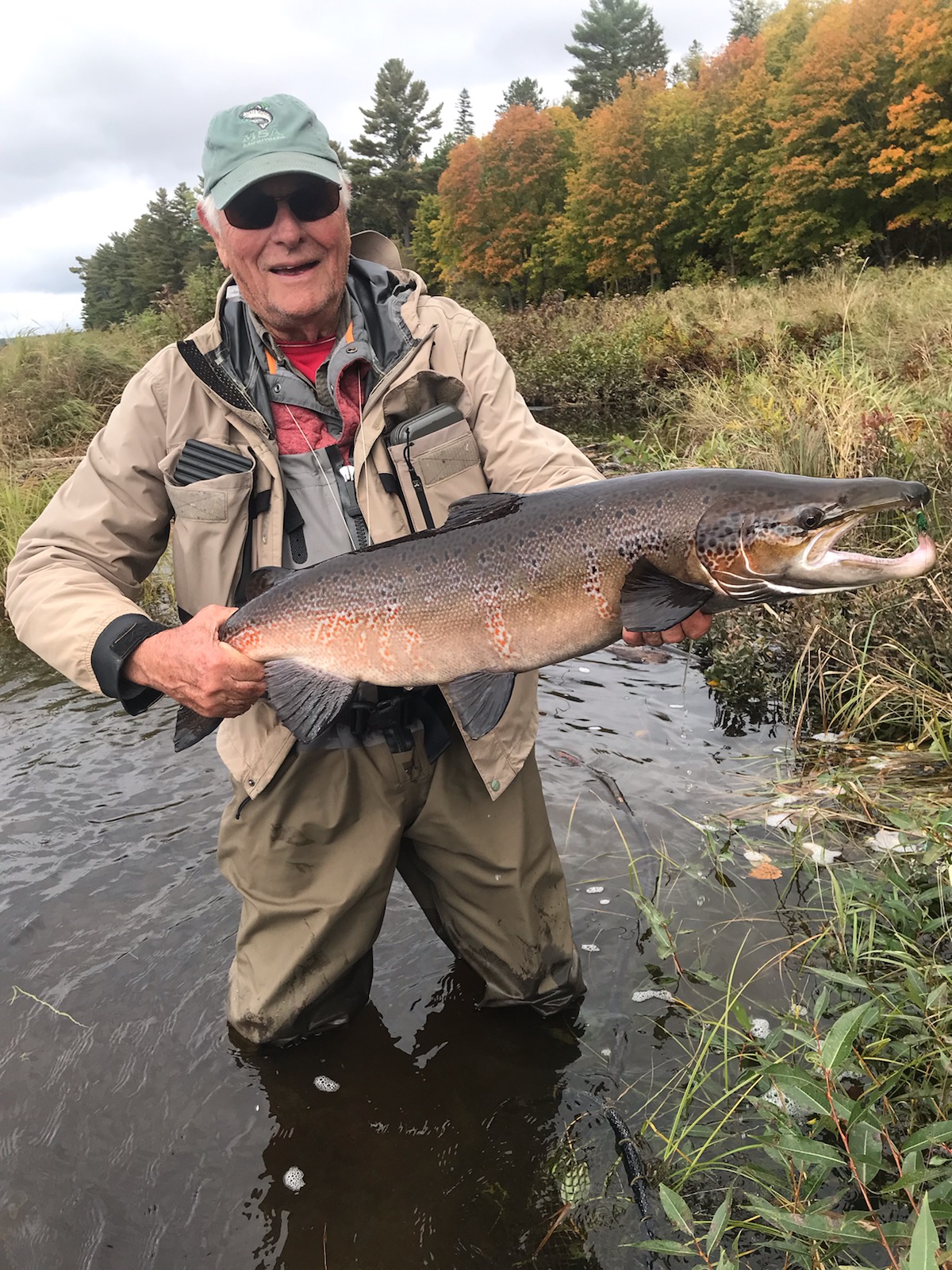

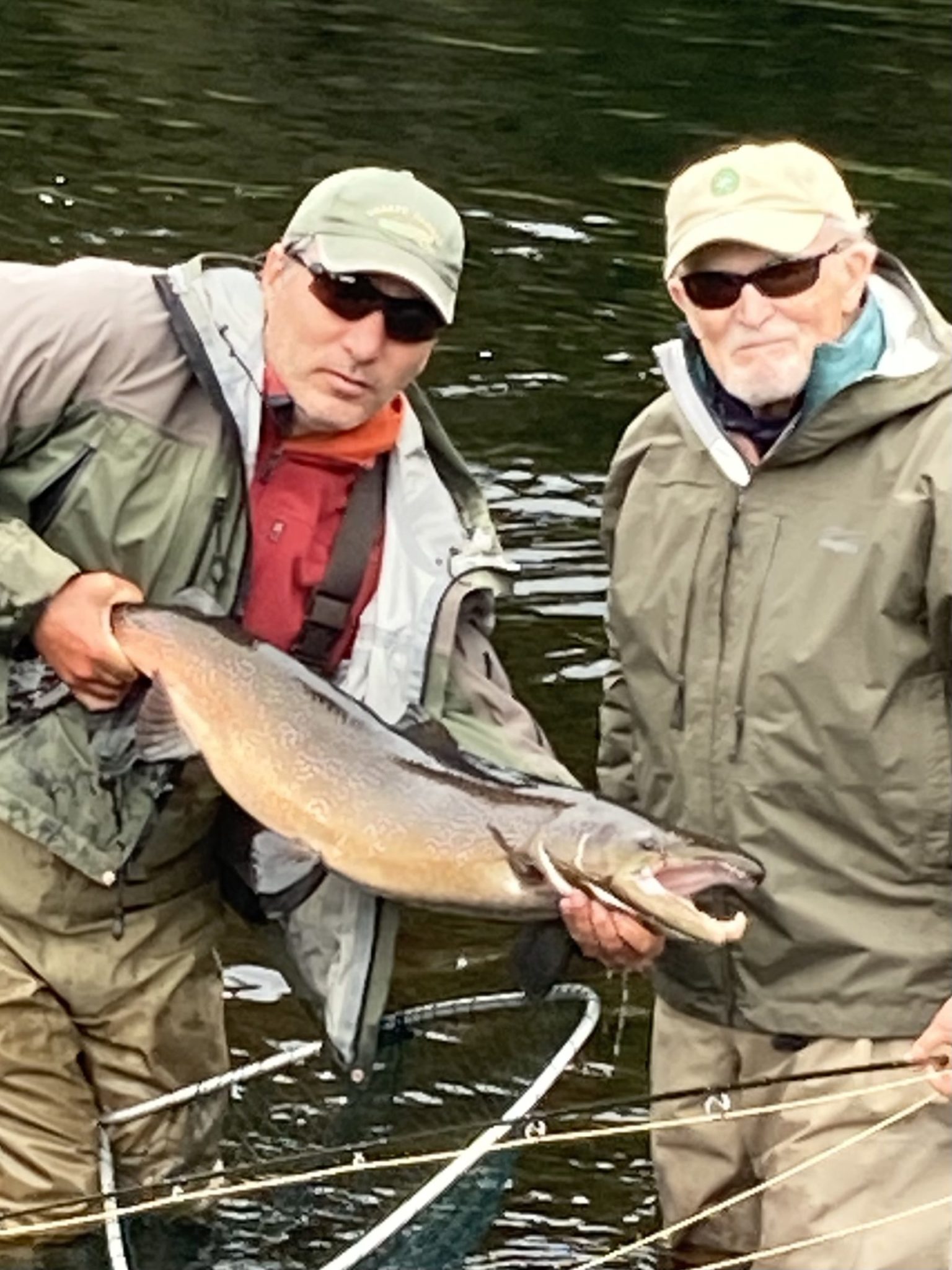
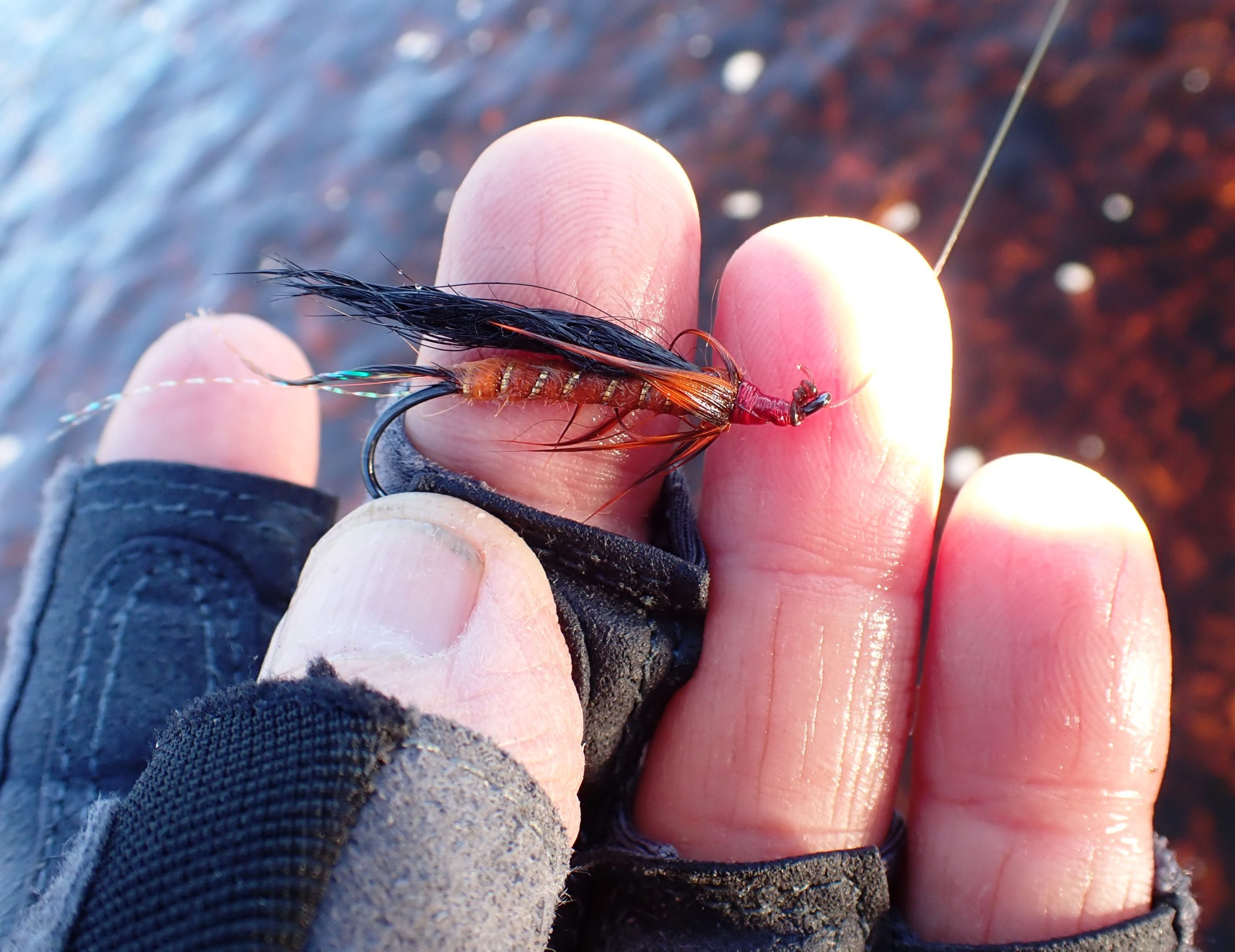
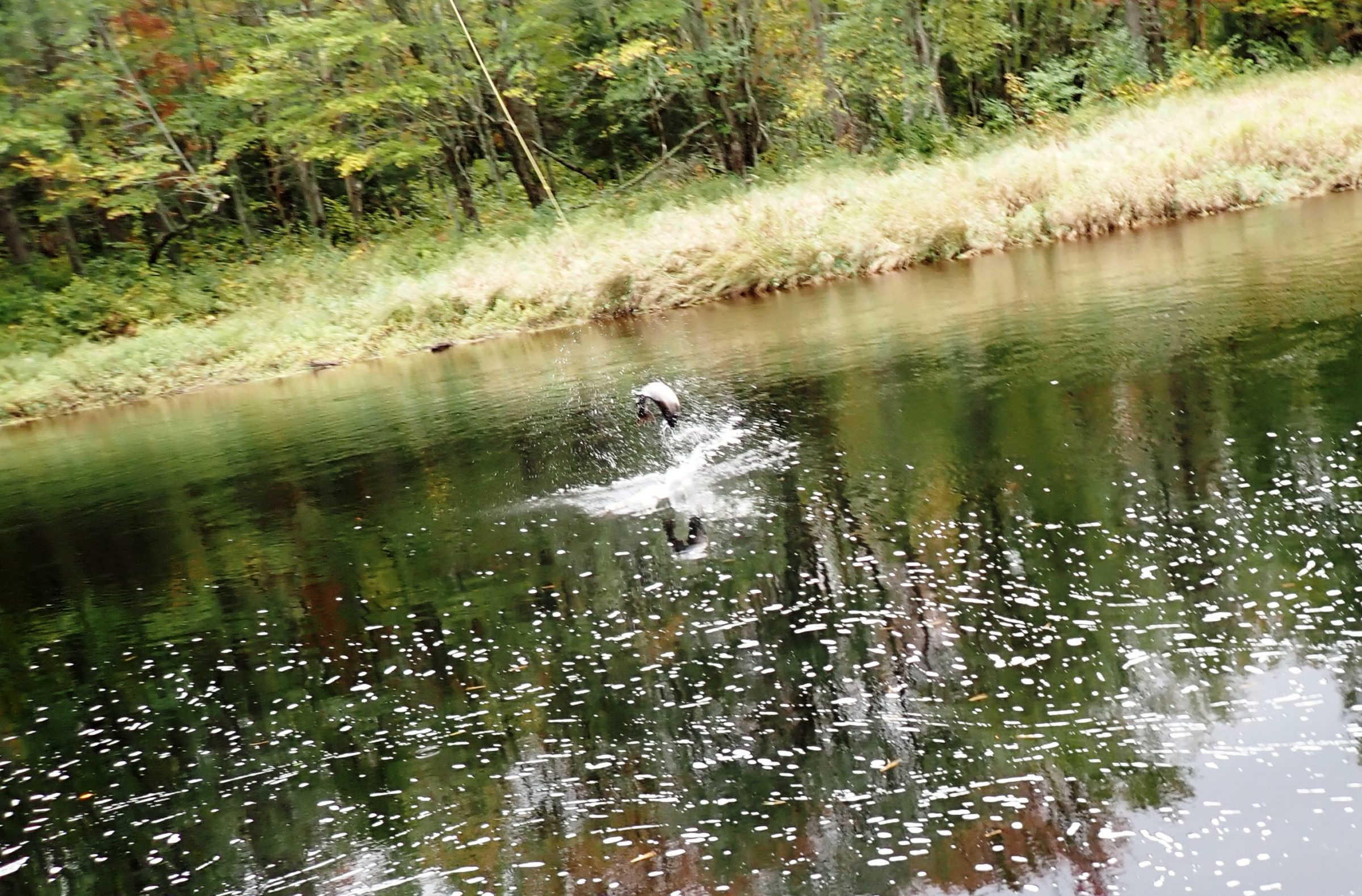
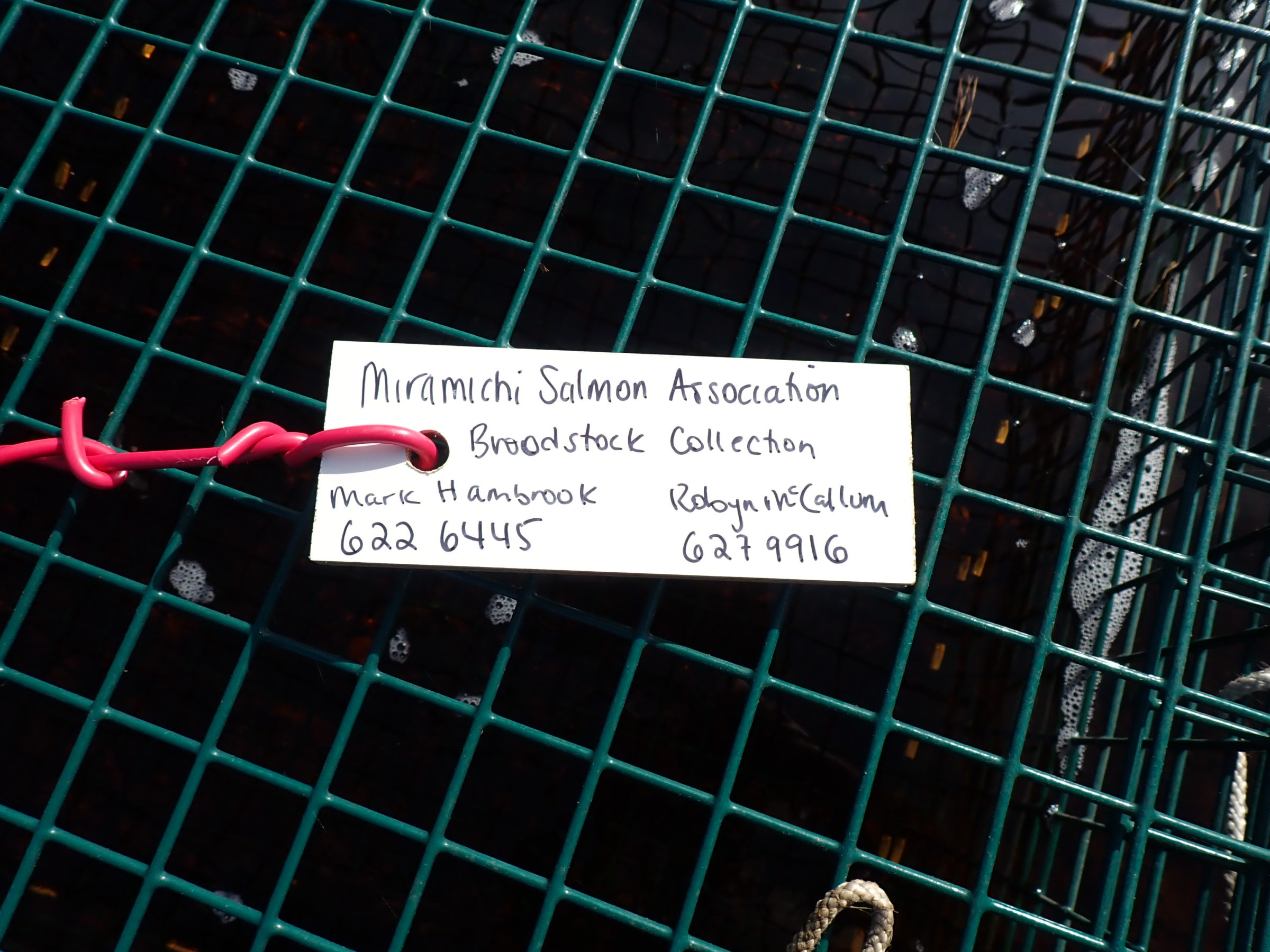
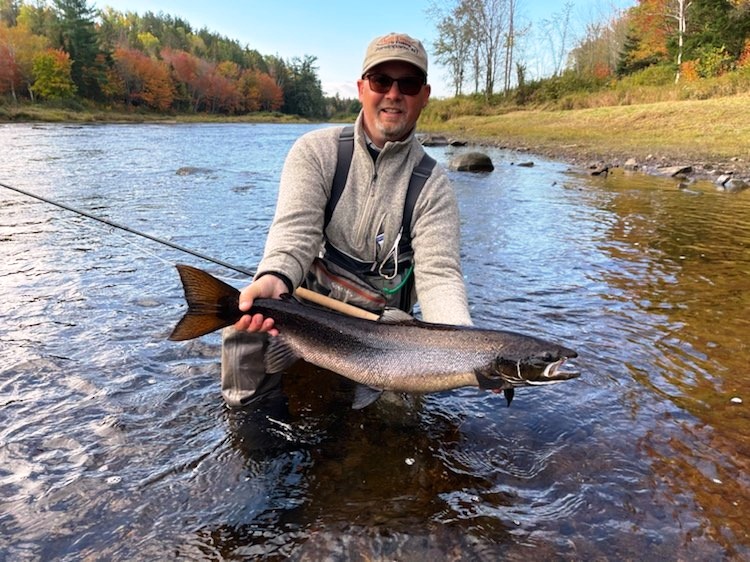
Hinckley is more than a veteran salmon angler.
Around Porter Brook, he is simply known as “The Legend”!
Thanks. I stand corrected…
Brad – I realize that, inexplicably, neither you, Jason nor Darrell witnessed the invasion of striped bass that we saw the last week of the season just a short distance upriver from Campbell’s. Now I also realize that the appearance of striped bass in the river in October is to be expected, especially in recent years with the dramatic recovery of the Gulf striped bass population. But, believe me, we have not seen anything like the numbers being hooked this past week. It was alarming and unprecedented, and you need not take my word for it. One obvious question is how widespread this was, and I hope your readers will respond. I’m concerned that the massive influx of striped bass we witnessed not be minimized or passed off as just another routine seasonal event. Miramichi salmon have enough to contend with without this upriver invasion of striped bass.
Pete – the week before you were invaded we had a couple days of regularly catching a bass or two with a pass down through Campbell’s. That was enough to depress me. Thankfully they seemed to move on, as we didn’t catch any that last week. It seems that they must have moved up to BBSC and stayed right there. As you know that is a unique pool, and they must have found something there in the confluence with the Cains that they liked. We fished Brophy, less than a mile upriver from there most days and never saw a striper. It appears, unfortunately, that BBSC hosted the whole damn school of them. Booh-hiss.
Brad,
Thanks for the fall update. Right after that picture was taken I did manage to land a nice 34″ hook nose.
Roger Earle
Roger – terrific! I somehow missed that additional information. Brad
I second Pete Howell’s concern about huge amounts of striped bass surging in the Miramichi. There are reports that one of the traps caught 2 grilse and 425 stripers in one day? A friend reported catching 73 fish in four hours by 2 adults and 2 kids.
I hope your second step analysis of the season captures this ongoing threat to salmon fishing as we know it and the seemingly insignificant response by the DFO…..allowing the small catch of immature fish while the population is exploding.
The failure to contain smallmouth bass after years of inaction, when the permits were finally secured, may be indicative of their true purpose? Stripers over salmon.
Thanks Brad for the running account on river activities. It certainly has been a year of highs and lows. High water and low fish counts but what the hell, any day on the river is a plus and to be cherished. As my friend used to say, « How could you hate it » Looking forward to next year.
Thanks for your sentiments Mel. I too am already very much looking forward to next year. The grilse count for this year is a very solid turn around, the river was full of parr, and we saw lots of salmon over a large area of the Cains River. The Miramichi certainly still has lots of promise.
Hi Brad- I was searching your reference above for the “October Killer” streamer and found a picture of the pattern in one of your previous updates from 2016.
That’s a great looking fly and would have come in handy for me last month on the York River in Gaspe during its very rapid rise and discoloration from a normal serene jade green color to dirty brown as the remnants of hurricane Ida blew thru the area. We caught several good salmon and grilse on Mickey Finns during the storm but a big “October Killer” looks like it would have been just perfect for those high/ off color water conditions.
I would love to try to tie a few up for next year. Do you or any of your followers have the recipe for that pattern?
Thanks!
Dave – pictures of the October Killer and the tying recipe are in my book Closing the Season which can be purchased from me on my website or new and used at Amazon. The fly is, though, really just a Mickey Finn with a few modifications. One of these is the addition of a layer of black in the bucktail, another is a couple of pieces of rainbow flashabou between each bucktail color, and the last is a palmer-wound hackle on the head – cascade style and in an Ally’s Shrimp. I use different colors on the hackles – sometime black barred orange or red, and sometimes just black. Sometimes I tie in two, an orange and a black. Many falls it is the only fly I fish for the last few weeks of the season. Brad
Brad: What a stellar trip fishing with you at Campbell’s Pool and on the Cains. You are a consummate host! Best wishes, Topher Browne
P.S. I fished White Birches (Ted Williams’s Camp) for two days on my way to Nova Scotia in early October (two+ weeks ago). I observed a local angler from New Brunswick catch and kill a fat striped bass at the mouth of the Sabbies River on the Cains River. I asked the angler if it would be alright if we examined the stomach contents. We removed the stomach of the striped bass, cut it open, and clearly observed two salmon parr in its belly. I would not have believed that striped bass were that far up the Cains River if I had not seen it with my own eyes.
Thanks for the kind words Topher. It was a pleasure having you in camp, and watching your Spey casting technique.
In some past years stripers have been confirmed as far up the Cains as the Moore Pool – another 7 or 8 miles from Sabbies. No question that we need to be able to remove all stripers that we catch above the head of tide, regardless of size or bag limit. Black Brook was besieged with bass at the very end of the season.